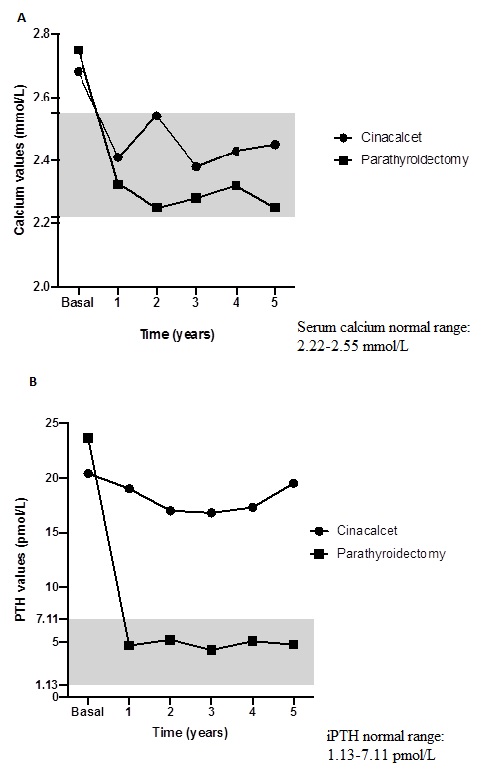Parathyroidectomy Remains Effective for Treating Tertiary Hyperparathyroidism: Long-Term Results of a Randomized Study
A. Coloma1, P. Moreno2, J. Torregrosa3, N. Montero1, A. Manonelles1, E. Melilli1, J. Cruzado1
1Nephrology, Hospital Universitari de Bellvitge, Hospitalet de LLobregat, Spain, 2Surgery, Hospital Universitari de Bellvitge, Hospitalet de LLobregat, Spain, 3Nephrology, Hospital Clinic, Barcelona, Spain
Meeting: 2020 American Transplant Congress
Abstract number: 127
Keywords: Bone, Hypercalcemia, Hyperparathyroidism, Kidney
Session Information
Session Name: Kidney: Cardiovascular and Metabolic Complications I
Session Type: Oral Abstract Session
Date: Saturday, May 30, 2020
Session Time: 3:15pm-4:45pm
 Presentation Time: 3:51pm-4:03pm
Presentation Time: 3:51pm-4:03pm
Location: Virtual
*Purpose: Tertiary hyperparathyroidism is a common cause of hypercalcemia after kidney transplant (KT). The aim of this study is to evaluate the long-term effectiveness of parathyroidectomy versus cinacalcet in patients with persistent hyperparathyroidism.
*Methods: A 12-month prospective, multicenter, open-label, randomized study demonstrated than subtotal parathyroidectomy is more effective than cinacalcet for controlling hypercalcemia caused by persistent hyperparathyroidism after KT. Now, we evaluate in the same cohort of patients if this effect is maintained after 5 years of follow-up. Laboratory assessment included serum calcium and phosphate, intact parathyroid hormone (iPTH), calcidiol levels, eGFR and proteinuria at 2, 3, 4 and 5 year follow-up.
*Results: At 5 years of follow-up, six of 13 patients(46%) in the cinacalcet group and ten of 11 patients(91%) in the parathyroidectomy group (P=0.03) achieved normocalcemia (Figure A). Subtotal parathyroidectomy maintained a greater reduction of iPTH compared with cinacalcet group (Figure B). Normalization of iPTH was accomplished in 7 of 11 patients(64%) in the parathyroidectomy group versus 1 of 13 patients in the cinacalcet group (P=0.001). However, no statistically significant differences were observed in kidney function between both groups. In relation of treatment, 8 of 13 patients in cinacalcet group maintained treatment with cinacalcet after 5 years follow-up compared with none of 11 patients in parathyroidectomy group (P=0.002). The doses were 30 mg every other day (31%), 30 mg daily (23%) and 60 mg daily (8%). In the cinacalcet group, one patient required subtotal parathyroidectomy for uncontrolled hyperparathyroidism. Therefore, subtotal parathyroidectomy can be considered superior in terms of cost-effectiveness.
*Conclusions: Subtotal parathyroidectomy is more effective maintaining normal serum calcium and iPTH in the long term compared with cinacalcet in kidney transplant patients with tertiary hyperparathyroidism.
To cite this abstract in AMA style:
Coloma A, Moreno P, Torregrosa J, Montero N, Manonelles A, Melilli E, Cruzado J. Parathyroidectomy Remains Effective for Treating Tertiary Hyperparathyroidism: Long-Term Results of a Randomized Study [abstract]. Am J Transplant. 2020; 20 (suppl 3). https://atcmeetingabstracts.com/abstract/parathyroidectomy-remains-effective-for-treating-tertiary-hyperparathyroidism-long-term-results-of-a-randomized-study/. Accessed January 7, 2026.« Back to 2020 American Transplant Congress

